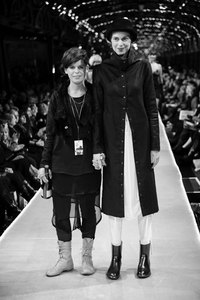Lela Jacobs of Lela Jacobs
How is preparation for iD going? Has it been stressful?
Not stressful at all. I came last year and I know how it works so I wasn’t concerned about that part of it. Having the launch in Wellington for the same collection also went really well. We got to trial all the looks and make sure that it all worked.
Could you tell me a little bit about the collection you are going to be showing? Your inspiration and mood? At the moment it’s very much about texture. Everything is quite dark, always monochrome. It’s all natural fibres, that's an important aspect of it. I have fabric that is hand loomed in Wellington, ponchos and scarves made out of possum and merino. I have goat, Japanese silk -it’s all very much about the fabrics that are being used, and the textures behind them.
The title “This Crooked Way” and the campaign for this season is [based on] photography by a lady called Megan Ellis. It has no people in it, it’s pure imagery that was shot on some islands off and around Tokyo. “This Crooked Way” is about venturing towards your way in life. Not necessarily the straight path taken, but the crooked path. Challenge, risk and your own path.
What is your opinion on “fast fashion” -cheap, disposable, mass-produced garments? It’s awful, there’s so much crap out there. People just keep consuming and buying and buying, but they’re buying rubbish. They’re buying shit that dies. Or maybe it’s a trend product that's valid for a very, very small amount of time. It may just be made of polyester, and it may just go into a landfill and never break down. And the amount of money that is spent on ten garments is a lot of money when you could buy something that is more expensive but beautiful, something that will last. You won’t ever want to throw it away and you won’t be getting rid of it. You will be giving it to someone, like maybe your child or your best friend or something like that. There’s so much poly-asta-shit out there and I hate it. I use natural fibres which will decompose and will break down over time. That's not a bad thing. That's natural.
Your collections tend to be quite androgynous. Do you design with gender in mind or is it something you find irrelevant? I think it’s irrelevant. I mean, I prefer a looser cut and this delivers an androgynous aesthetic a lot of the time. Also, New Zealand guys are willing to take more of a challenge or risk nowadays with what they are going to wear. It's no longer just a t-shirt and jeans scenario.
Collaborations have played an important part in your past collections, have you incorporated any into “This Crooked Way”? I love collaborations. The poncho from this collection was a collaboration with Harrison Gyde. It was hand-loomed out of possum and merino and it took forever, there were only a small number of them made. Every garment goes out with a swing tag, which has a section on it that has finite editions so people know how many of each garment they are buying into. Collaborations happen every season with artists, different people, whoever comes along. There’s no print in “This Crooked Way” because no one was really there at that time. I’m not big on going out searching. It’s very natural, situation by situation.
What can we look forward to seeing for next season? Next summer is looking interesting. A little more “feminine” I guess. I can’t give too much away as its not released until September, but “Echoes of Awe” is going to be the name.
And locally, where can we find your garments for sale? Belle Bird.



